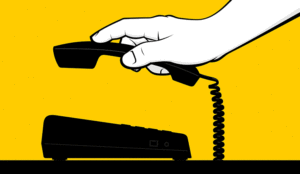When people contact your customer service team, they want fast answers to their queries. They don’t want to be waiting in queue to get through to an agent.
Failing to value customers’ time or making the IVR process too complex when they call will cause them to abandon their calls, irritate them, and potentially lead them to move their business elsewhere.
In fact, the latest data from ContactBabel suggests that call abandonment rates are on the rise, and this is an issue that needs fixing in many organisations.
However, it’s not just a question of simply investing in more staff or resources. Resourcing your contact centre involves a delicate balance between ensuring you’re able to meet customer needs without long delays (and cut the risk of abandoned calls) and operating efficiently.
The key to reducing call abandonment rates lies in understanding why customers hang up and then addressing these issues. The following seven steps can help:
1. Understand the Data
If you analyse incoming customer calls, you’ll be able to see the patterns around when customers enter your telephony queue and when they tend to drop out.
Keep reviewing this abandonment curve and look for potential triggers. For example, do customers drop out when they hear a specific message? Does abandonment vary between times of day or days of the week – or type of call?
Also identify what percentage of abandonments are ‘good’ abandons, where the message you are giving deflects people to get information from alternative channels or resources. Essentially, use your call data to put in place the right changes to tackle the problem.
2. Understand Customer Behaviour
By better understanding customer demographics and behaviour, you can reduce call abandonment. For example, many customers prefer to use other channels (such as web self-service, or chat). Are you making them aware of these alternative options, especially in on-hold messages?
Talk to the wider company too to be ready for potential spikes. For example, activity around a particular promotion or new product launch. This enables you to resource effectively to cover peaks in demand.
3. Deflect What You Can
One way to reduce call abandonment is to deflect. Many people have routine queries for which they don’t really want to speak to someone.
They just want fast answers, so give them alternatives that meet their needs. For example, include routine information such as opening hours upfront in your customer service welcome message. Or automatically provide answers to the most common questions via your IVR.
Adopting these tactics not only reduces the overall number of incoming calls, but also frees up staff time to answer other queries.
4. Offer Call-Backs
If the contact centre is extremely busy, show customers that you value their time by offering to call them back. Instead of making them hang on the line, provide the option to leave a message and request a call-back while retaining their place in the queue.
Their message is then treated just like a caller on hold and is delivered to the next available agent. They can simply listen to the message and click to automatically call the customer back.
5. Add More Humans
Based on previous years, be mindful of peaks when call volumes will be higher, such as Black Friday, and resource accordingly. Be flexible and agile to make sure you work as efficiently as possible.
For example, look to blend agents between channels (depending on levels of demand) or even deploy non-agents with the right knowledge to respond to customers during peak periods.
Remember that the combination of a cloud contact centre and hybrid working now makes the process of adding resources much easier and quicker.
With cloud-based systems, agents can simply log on from home to provide short-term support, rather than having to travel to and from the contact centre to work.
Obviously if problems persist and you cannot cope with the volume of calls, you’ll have to recruit more agents. While this is an additional cost, remember that failing to get a fast answer is one of the number one reasons customers leave.
6. Give People an Idea of How Long They’ll Need to Wait
One of the issues that leads to irritation and call abandonment is that customers often have no idea how long they’ll need to hang on until their call is answered.
So, give people a realistic expectation of when their call will be put through to an agent, by regularly updating them about their position in queue and the likely time to answer. By doing this you can help customers plan as well as give them more confidence that their call will be answered eventually.
It’s also a good idea to try and vary the content of on-hold messages callers must listen to when waiting. Nothing annoys people more than hearing the same message multiple times.
You could explore what competitors or similar brands do with their on-hold messages and see if there are any useful learnings you can incorporate.
7. Increase Efficiency
If you can reduce the time agents spend on each call, without impacting quality of service, then logically they will be able to manage more calls per hour (which is likely to result in fewer abandonments).
So, look for ways to support agents in reducing Average Handling Time. Here are some of the things to consider:
- Automate caller authentication so it happens while the customer is still queuing
- Empower agents with answers via a knowledge base to make it easier and faster to answer queries
- Arm agents with customer information via CRM integration
- Provide agents with access to all the systems they need, seamlessly via a unified agent desktop, to avoid them wasting time switching between systems
- Automate the post-call wrap-up process
- Analyse calls and Voice of the Customer feedback to identify where individual improvements can be made (through agent coaching) or processes changed
Remember that increasing efficiency doesn’t just reduce call abandonment rates, it benefits overall customer service levels and optimises your resources.
The phone is still the busiest customer service channel for most organisations today. That makes reducing call abandonment rates vital if you are to keep customers happy and ensure operational efficiency.
This blog post has been re-published by kind permission of Enghouse Interactive – View the Original Article
For more information about Enghouse Interactive - visit the Enghouse Interactive Website
Call Centre Helper is not responsible for the content of these guest blog posts. The opinions expressed in this article are those of the author, and do not necessarily reflect those of Call Centre Helper.
Author: Enghouse Interactive
Published On: 18th Oct 2022
Read more about - Guest Blogs, Enghouse Interactive






 Enghouse Interactive delivers technology and expertise to help bring your customers closer to your business through its wide range of customer contact solutions.
Enghouse Interactive delivers technology and expertise to help bring your customers closer to your business through its wide range of customer contact solutions. 








